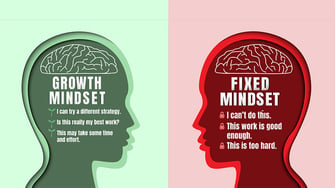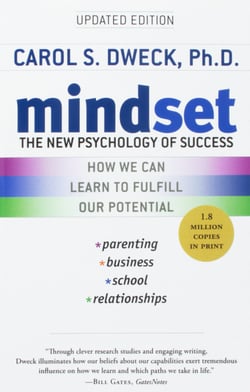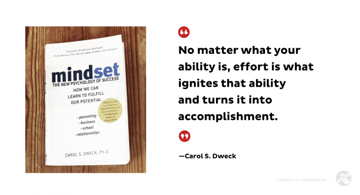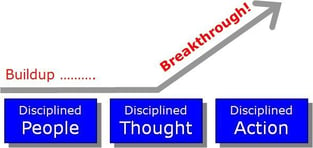 “Battles are won by the power of the mind” ~Napoleon
“Battles are won by the power of the mind” ~Napoleon
Carol Dweck’s book, Mindset: The New Psychology of Success presents a strong case for the power of having a growth mindset, whether its’ business, being a parent, or relationships. A Growth Mindset isn’t a prerequisite for success; however, it is a powerful molder of our ability to be resilient to overcome failure and learn how to become better.
Mindset: Fixed or Growth?
Do you have a fixed or a growth mindset? How does this matter? To discover your mindset, check out this short 8 question survey at Interactive Quiz: Fixed vs Growth Mindsets
A growth mindset is generally better than a fixed mindset. A Growth mindset turns failure into a gift. And as we pointed out in Kids Say the Darndest Things – Formula for Human Potential it’s all about your attitude.
For an Infographic on the differences between Growth and Fixed Mindset, go to Fixed VS. Growth: How Your Mindset Dictates Your Success [Infographic]
Watch this 8-minute video to learn more about the difference between a Growth and a Fixed Mindset:
Can you be a success with a Fixed Mindset?
As the video helps explain, a Growth Mindset helps set the stage for growth and achievement. Yet as Carol Dweck shares in Mindset: The New Psychology of Success,  a fixed mindset didn’t prevent Bobbie Knight or Pat McEnroe from enjoying success in their sports vocations. Lee Iacocca, at Chrysler, and Kenneth Lay and Jeffrey Skilling of Enron, certainly also enjoyed success for a time, yet eventually faltered.
a fixed mindset didn’t prevent Bobbie Knight or Pat McEnroe from enjoying success in their sports vocations. Lee Iacocca, at Chrysler, and Kenneth Lay and Jeffrey Skilling of Enron, certainly also enjoyed success for a time, yet eventually faltered.
As Dweck points out, “they all start with the start with the belief that some people are superior; they all have the need to prove and display their superiority; they all use their subordinates to feed this need, rather than fostering the development of their workers; and they all end by sacrificing their companies to this need.”
Groundhog Day
Bill Murray is a classic fixed mindset example in the movie Groundhog Day. Here’s a short clip on how Murray goes from a fixed mindset to a growth mindset, realizing he can change, and in doing so, change his outcome, and win the heart of his news producer, Rita (Andie McDowell).
Hopefully, it doesn’t require the kind of carnage Murray goes through for most of us to change to a growth mindset.
Dweck answers several questions about mindsets in her book. Here are two I thought are relevant for this blog:
Question: Are mindsets a permanent part of your makeup or can you change them?
Yes, you can change your mindset, and it starts with awareness. As coaches, leaders, parents, and teachers we can fall victim to putting those we lead into a fixed mindset. Dweck has a chapter dedicated to how to change your mindset which you can see some pointers in the previous video.
When I was a young boy, I had a severe disappointment in basketball, playing as the tallest boy on the C team, I was embarrassed. I thought I was a failure. I was going through a growth spurt. My body hadn’t caught up with my mind. I was uncoordinated. I’d not invested the time in practicing either. I vowed to practice an hour a day every day. In time my growth, my disciplined practice helped me evolve into a good player.
 Question: Can I be half-and-half? I recognize both mindsets in myself.
Question: Can I be half-and-half? I recognize both mindsets in myself.
Dweck’s answers, “Many people have elements of both. People can also have different mindsets in different areas. I might think that my artistic skills are fixed but that my intelligence can be developed. Or that my personality is fixed, but my creativity can be developed. We’ve found that whatever mindset people have in a particular area will guide them in that area.”
For example, I have a fixed mindset when it comes to repairing and fixing anything mechanical. My history has shown me when I try to fix things myself, I grow impatient, frustrated, and upset. I’ve learned it’s much better to hire someone who can do this for me, rather than try to spend an inordinate amount of time trying myself, only to make it worse than I started. I have a fixed mindset on mechanical repairs. Can I change it? I’m sure I can, with patience, time, and better self-control. I choose to hire someone, so I can invest my time somewhere else to enjoy my life more.
The tools we use in Scaling UP and 3HAG Way are growth mindset resources.
It’s especially important to conduct interviews to discover this mindset, which is accomplished through the Topgrading process.
To create an environment where everyone is inspired to give their best, contact us today to schedule a free exploratory meeting.
Growth demands Strategic Discipline.
 To build an enduring great organization, requires disciplined people, disciplined thought, disciplined action, to produce superior results, and make a distinctive impact in the world.
To build an enduring great organization, requires disciplined people, disciplined thought, disciplined action, to produce superior results, and make a distinctive impact in the world.
Discipline sustains momentum, over a long period of time, laying the foundations for lasting endurance.
-2.jpg?width=328&name=3%20Disciplines%20of%20Execution%20(Strategic%20Discipline)-2.jpg) A winning habit starts with 3 Strategic Disciplines: Priority, Metrics and Meeting Rhythms. Forecasting, accountability, individual, and team performance improve dramatically.
A winning habit starts with 3 Strategic Disciplines: Priority, Metrics and Meeting Rhythms. Forecasting, accountability, individual, and team performance improve dramatically.
Meeting Rhythms achieve a disciplined focus on performance metrics to drive growth.
Let Positioning Systems help your business achieve these outcomes on the Four most Important Decisions your business faces:
|
DECISION |
RESULT/OUTCOME |
|
PEOPLE |
|
|
STRATEGY |
|
|
EXECUTION |
|
|
CASH |
|
Positioning Systems helps mid-sized ($5M - $250M) business Scale-UP. We align your business to focus on Your One Thing! Contact dwick@positioningsystems.com to Scale Up your business! Take our Four Decisions Needs Assessment to discover how your business measures against other Scaled Up companies. We’ll contact you.
 NEXT BLOG – What’s a swim lane?
NEXT BLOG – What’s a swim lane?
A swim lane is a term from Shannon Susko’s book 3HAG WAY. It refers to key developments in a businesses path to differentiating itself in the marketplace to achieve it’s 3 Year Highly Achievable Goal. Will examine Swim Lanes, and why they’re so essential to achieving your 3 Year Plan, next blog.






.jpeg?width=150&height=135&name=Hand%20with%20marker%20writing%20the%20question%20Whats%20Next_%20(1).jpeg)

